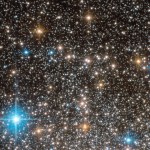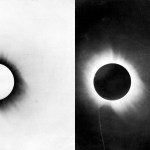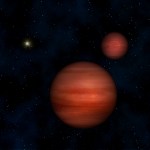Stars
“Normal science, the activity in which most scientists inevitably spend almost all their time, is predicated on the assumption that the scientific community knows what the world is like.” -Thomas S. Kuhn
For all of human history, the biggest questions have fascinated us. Where did the Universe come from? How old is it? And what is its ultimate fate? Once relegated to the realm of theologians, poets, and philosophers, science has brought us closer than ever to the answers. But scientific revolutions have occurred before, in many cases significantly changing the answers to these and other…
"O. Hahn and F. Strassmann have discovered a new type of nuclear reaction, the splitting into two smaller nuclei of the nuclei of uranium and thorium under neutron bombardment. Thus they demonstrated the production of nuclei of barium, lanthanum, strontium, yttrium, and, more recently, of xenon and caesium. It can be shown by simple considerations that this type of nuclear reaction may be described in an essentially classical way like the fission of a liquid drop, and that the fission products must fly apart with kinetic energies of the order of hundred million electron-volts each." -Lise…
"Hubble often takes images of distant gravitationally lensed galaxies to infer their substructure and to try to learn about early galaxies in general. For LUVOIR, we would have that same resolution for any galaxy! That’s truly revolutionary." -John O'Meara
If you were an observational astronomer, what would your dream telescope look like? It would have to be huge, with an incredible amount of light-gathering power. The quality of the optics would have to be pristine, and higher-precision than anything ever created before. It would have to have multispectral capabilities, extending beyond both…
"We are what we are, and we're doing the best we can. It is not for you to set the standards by which we should be judged!" -Capt. Picard, to Q
When you think about Star Trek, a whole variety of things might come to mind. It might conjure images of space exploration, feelings of optimism about the future of humanity, the inextricable link between prosperity and technology, or the fear of the unknown. But what has always set Star Trek apart from any other sci-fi or fantasy show has been its ability to hold a mirror up to humanity, and force us to confront our greatest moral and ethical…
“The bedrock nature of space and time and the unification of cosmos and quantum are surely among science’s great ‘open frontiers.’ These are parts of the intellectual map where we’re still groping for the truth – where, in the fashion of ancient cartographers, we must still inscribe ‘here be dragons.'” -Martin Rees
Inside the nuclear furnace of the Sun, protons and other atomic nuclei are compressed together into a tiny region of space, where the incredible temperatures and energies try to overcome the repulsive forces of their electric charges. At a maximum temperature of 15 million K, and…
"The older you get, the more you realize that the way you look is a reflection of how you treat yourself." -Hope Davis
Age may be just a number, but in cosmic terms, there are some rules it’s pretty important to obey. It should be impossible to have a complex creature that’s older than the planets; a rocky planet that predates the stars; or a star that’s older than the Universe itself. With a figure of 13.8 billion years, we’ve arrived at an incredibly accurate estimate for the age of the Universe since the Big Bang from a slew of different sources, and so nothing should be older than that.…
"The sun is a miasma Of incandescent plasma The sun's not simply made out of gas No, no, no The sun is a quagmire It's not made of fire Forget what you've been told in the past" -They Might Be Giants
Ask anyone where the Sun (or any star) gets its energy from, and most people will correctly answer “nuclear fusion.” But if you ask what’s getting fused, most people -- including most scientists -- will tell you that the Sun fuses hydrogen into helium, and that’s what powers it. It’s true that the Sun uses hydrogen as its initial fuel, and that helium-4 is indeed the end product, but the…
"Comrades, this man has a nice smile, but he's got iron teeth." -Andrei A. Gromyko
When you have a star, perhaps its most defining characteristic is that it fuses lighter elements into heavier ones, releasing energy. While all stars fuse hydrogen into helium, the more massive ones will undergo helium fusion, with the most massive also fusing carbon, oxygen, and eventually silicon, producing iron in the end. By time you get to iron, the most stable element of all, you would lose energy if you fused anything further, so iron’s the end-of-the-road, with a supernova as the next inevitable step.…
"The origin and evolution of life are connected in the most intimate way with the origin and evolution of the stars." -Carl Sagan
When it comes to dying stars, supernovae get all the press. They may be the largest and most massive stars to die, but hundreds of times more common are the planetary nebulae of the Universe, formed by dying Sun-like stars. These astronomical wonders blow off their outer layers -- not just hydrogen but also heavier elements -- to return them to the interstellar medium.
In this contrast-enhanced view, the structure of the evaporating gas globules at the interior…
"Presently thought to be the most powerful explosions in nature... their sources have only recently been localized by observations of associated afterglows in X-rays, visible light, and radio waves, delayed in that order." -Richard Matzner, on the dictionary entry for Gamma Ray Burst
It seems like an eternity ago, but it’s been under two years since LIGO first began the science run that would first detect merging black holes. Their latest scientific data run is scheduled to end in just two days, and thus far, they’ve announced a total of three black hole-black hole merger discoveries, along…
"A candidate is not going to suddenly change once they get into office. Just the opposite, in fact. Because the minute that individual takes that oath, they are under the hottest, harshest light there is. And there is no way to hide who they really are." -Michelle Obama
The most massive stars in the Universe are true behemoths, rising to hundreds of times the mass of our Sun and burning at temperatures upwards of 30,000 K at their surface. But there are stars out there that are even hotter, despite only being 10% or less as massive: Wolf-Rayet stars. The key to their cosmic success? Blowing…
“We [are] a species endowed with hope and perseverance, at least a little intelligence, substantial generosity and a palpable zest to make contact with the cosmos.” -Carl Sagan
When the Voyager and Pioneer spacecraft were launched, they contained a message emblazoned on them: a map of 14 pulsars, showing the location of Earth relative to them. This was a brilliant idea: showcase bright, unique identifiers, complete with their observed periods and distances from our world, and people would be able to find Earth. If we wanted to be found, it was the best idea 1977 had to offer.
A colorized…
"Yes, I am well aware that nature -- or what we call nature: that totality of objects and processes that surrounds us and that alternately creates us and devours us -- is neither our accomplice nor our confidant." -Octavio Paz
For most of us heading to the path of totality, we're in for an incredible experience. If we get clear skies, it will take roughly an hour for the Moon to pass in front of the Sun's disk completely, and after that we'll get just over two minutes of totality: an experience like no other. Yet if you're not careful -- or if you get too excited about one particular thing…
"...and the Sun has perished out of heaven, and an evil mist hovers over all." -Homer's Odyssey
The great american eclipse is coming, and you're in luck! This astronomical sight is unlike anything else that occurs on Earth (or any rocky planet in the Solar System), and there are three incredible stories that it teaches us about the world. First, there's the incredible story about the Moon, Earth, and Sun in orbit, teaching us about our solar system, alignments, and even the curvature of the Earth.
An illustration of the Sun-Moon-Earth configuration setting up a total solar eclipse. The Earth…
"The discovery of deuterium and the marked differences in the physical and chemical properties of hydrogen and deuterium, together with an efficient method for the separation of these isotopes, have opened an interesting field of research in several of the major branches of science." -Harold Urey
By time the first few minutes of the Big Bang are over, the Universe has formed all the elements it’s ever going to form until the first stars are born. At that point, the Universe is made out of 75% hydrogen and 25% helium, with only tiny, trace amounts of other isotopes and elements like deuterium…
"Eddington had needed to make significant corrections to some of the measurements, for various technical reasons, and in the end decided to leave some of the Sobral data out of the calculation entirely. Many scientists were suspicious that he had cooked the books. Although the suspicion lingered for years in some quarters, in the end the results were confirmed at eclipse after eclipse with higher and higher precision." -Peter Coles
If ever you attempt to come out with a new scientific theory, there are three criteria you must fulfill:
You must reproduce all the successes of the old theory,…
"[Brown dwarfs] appear to live a more exciting life than we presumed. They are too big to be planets and two small to be stars, but it does appear that if you watch one it has very active events... there is action going on." -Lars Bildsten
For every star that’s out there in the Universe, for every object that ignited hydrogen fusion in its core, there are many other objects out there that never got massive enough to do so. The largest failures, those that gathered between 13 and 80 Jupiter masses’ worth of material, are known as brown dwarfs. They achieve deuterium fusion in their core,…
"It shows you exactly how a star is formed; nothing else can be so pretty! A cluster of vapor, the cream of the milky way, a sort of celestial cheese, churned into light." -Benjamin Disraeli
From here on Earth, most of the stars we see in the night sky are ancient, having departed from the star-forming regions and open clusters that spawned them many millions or even billions of years ago. But there are still new stars forming in the Milky Way, and the vast majority of these star-forming regions are located in the galactic plane itself.
The Omega nebula, known also as Messier 17, is an…
"Not all chemicals are bad. Without chemicals such as hydrogen and oxygen, for example, there would be no way to make water, a vital ingredient in beer." -Dave Barry
When we break out the big guns -- space telescopes like Hubble or James Webb -- we can see the Universe as it was billions of years ago, if we look for long enough. From the first moment that the Universe forms stars and galaxies, so long as that light has a path to our eyes, humanity can view it with the right equipment. This record-breaking approach has brought us in contact with galaxies from as early as when the Universe was…
"Billions of years from now our sun, then a distended red giant star, will have reduced Earth to a charred cinder." -Carl Sagan
“Bigger mass makes a bigger star,” you might be inclined to say. The smallest stars in size should be small because they have the least amount of material in them, while the largest ones of all are the largest because they’ve got the most material to make stars out of. And that’s a tempting explanation, but it doesn’t account for either the smallest stars or the largest ones in the Universe.
The (modern) Morgan–Keenan spectral classification system, with the…



















